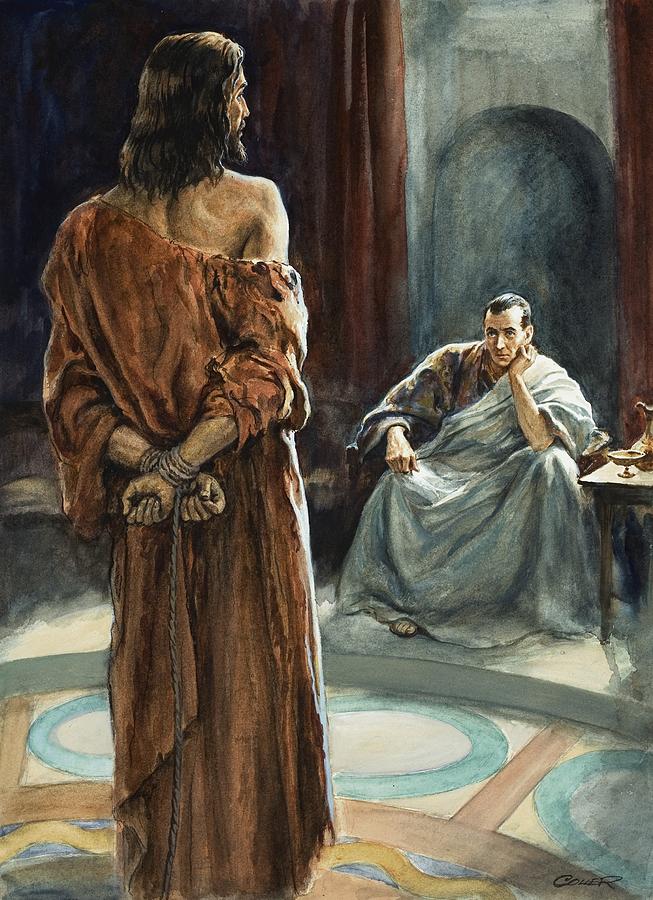Pontius Pilate: The Enigmatic Figure In History And Religion
Pontius Pilate, a name that echoes through the annals of history and religious texts, remains one of the most scrutinized figures from antiquity. As the Roman governor of Judea, he played a crucial role in the trial and crucifixion of Jesus Christ, events that would shape the course of Western civilization. His actions and decisions have been debated, analyzed, and interpreted in various ways, making him a figure of intrigue for historians, theologians, and the general public alike.
Pontius Pilate's legacy is not just confined to the pages of the Bible but extends into various cultural narratives, art, and literature over the centuries. The complexities of his character and the historical context in which he operated continue to provoke questions about justice, authority, and morality. This article will explore the life, actions, and enduring significance of Pontius Pilate, shedding light on why he remains a subject of fascination today.
As we delve deeper into the life of Pontius Pilate, we will explore his biography, the political climate of Judea during his governance, and the historical implications of his decisions. Additionally, we will address the various interpretations of his character and the impact he has had on religious and historical discourse. By understanding Pontius Pilate, we can gain insight into a pivotal moment in human history that continues to resonate with us.
Who Was Pontius Pilate?
Pontius Pilate was a Roman governor who ruled Judea around 26-36 AD. His tenure is primarily noted for his involvement in the trial of Jesus Christ, as recounted in the New Testament. Often depicted as a reluctant ruler caught between the demands of the Jewish authorities and the expectations of the Roman Empire, Pilate's historical portrayal varies widely.
What Do We Know About His Early Life?
Details about Pilate's early life are sparse, and much of what we know is derived from historical texts and biblical accounts. He was likely born into a Roman family and grew up in an environment steeped in the complexities of Roman governance and military affairs.
What Were His Major Accomplishments?
During his time as the governor of Judea, Pilate faced several challenges, including managing local unrest and maintaining Roman authority over the Jewish population. Some of his key accomplishments include:
- Implementing Roman infrastructure projects.
- Maintaining relative peace during his early years in office.
- Handling the complexities of Jewish religious law in relation to Roman law.
What Events Led to the Trial of Jesus?
The trial of Jesus is perhaps the most significant event associated with Pontius Pilate. Tensions were high in Judea due to social, political, and religious unrest. Jesus, seen by many as a revolutionary figure, was accused of blasphemy and sedition. Pilate's role in this trial is crucial, as he was the one who had the authority to pass judgment.
How Did Pilate Handle the Trial of Jesus?
Pilate's handling of the trial of Jesus is often depicted as a struggle between his desire for justice and the pressures exerted by the Jewish leaders and the crowd. Despite finding no fault in Jesus, Pilate ultimately yielded to public pressure and ordered his crucifixion. This decision has sparked debates about moral responsibility and the nature of justice.
What Is the Legacy of Pontius Pilate?
The legacy of Pontius Pilate is complex and multifaceted. He is often viewed as a symbol of moral ambiguity, representing the conflict between personal ethics and political expediency. Pilate's actions have been interpreted in various ways, leading to a wide range of cultural and religious narratives. His name has become synonymous with betrayal and cowardice, yet some scholars argue that he acted in accordance with the political realities of his time.
How Has Pilate Been Portrayed in Art and Literature?
Pontius Pilate's character has been a subject of fascination in art and literature throughout history. From paintings to plays, many artists and writers have explored his role in the crucifixion of Jesus, often portraying him in a light that emphasizes his internal conflict and moral quandaries.
What Are Some Notable Works Featuring Pontius Pilate?
Several notable works have depicted Pontius Pilate, including:
- "The Trial of Jesus" by various artists during the Renaissance.
- "The Life of Jesus" by Émile Zola.
- "The Last Temptation of Christ" by Nikos Kazantzakis.
Why Does Pontius Pilate Continue to Captivate Us?
Pontius Pilate's enduring fascination lies in his embodiment of the conflict between power and morality. His story raises essential questions about accountability, justice, and the consequences of inaction. As society grapples with similar dilemmas, Pilate’s narrative remains relevant, prompting reflection on how we navigate the complexities of ethical decision-making.
| Personal Details | Bio Data |
|---|---|
| Name | Pontius Pilate |
| Title | Roman Governor |
| Born | Unknown |
| Died | Unknown |
| Years Active | 26-36 AD |
| Notable Actions | Trial of Jesus Christ |
In conclusion, Pontius Pilate represents a pivotal figure in the intersection of history and religion. His life and actions invite us to reflect on the complexities of morality, authority, and human nature. By examining the legacy of Pontius Pilate, we can glean insights into the enduring struggles that define our own time.
Deion Baseball: The Multifaceted Journey Of A Sports Icon
Unraveling The Dark Mysteries Of The 1980 Murders
Exploring The Mystical World Of William Blake


